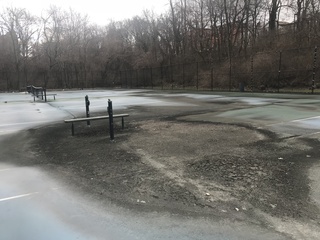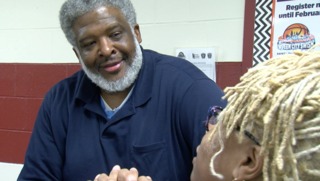CINCINNATI -- As Councilwoman Tamaya Dennard drove along Vine Street on a Saturday afternoon a few weeks ago, she saw a bored-looking boy standing on the sidewalk throwing rocks at cars.
“I stopped and got out and told him he shouldn’t be doing that,” Dennard said. “I would have loved to have said to him, 'Why don’t you go over to the rec center?' But I couldn’t -- it was Saturday at like 2 or 3 o’clock in the afternoon.”

Most of the city’s recreation centers are closed on weekends, including many in disadvantaged neighborhoods such as West Price Hill, Millvale, Winton Hills, West End and Bond Hill.
Only seven of the city’s 23 recreation centers are open on Saturdays, usually just for a few hours, and all are closed on Sundays.
In the face of deep city budget cuts for more than a decade, the Cincinnati Recreation Commission has been forced to reduce hours as it struggles to make basic repairs to dozens of outdated recreation centers, tennis and basketball courts and pools across the city.
This situation has no immediate fix -- even as a giant sinkhole takes over one tennis court in Kennedy Heights and three recreation centers closed recently for asbestos removal.
“We’re getting into a crisis situation," said Vice Mayor Christopher Smitherman, who believes the city should issue debt to pay for repairs. "I estimate we have $55 to $60 million in deferred maintenance in recreation centers."

Lang Tennis Courts in Kennedy Heights is closed because of a giant sinkhole.
The situation will likely worsen this year as the city faces an estimated $23.4 million projected budget deficit, which could reach $30 million, and funding for recreation is on the cutting block again.
“We’ve gotten behind in just about every area of capital maintenance, whether it’s our indoor facilities or outdoor facilities,” said Cincinnati Recreation Commission director Daniel Betts. “We’re probably worse off on the outdoor -- our tennis courts, our basketball courts.”
A sinkhole at Lang Tennis Courts in Kennedy Heights is at least 10 feet wide and several feet deep. It cannot reopen as a tennis court because of a deep collapsed sewer underneath.
Recreation leaders hope to convert the usable space to a pickleball court (a paddle sport that combines elements of badminton, tennis, and table tennis), which has community support. But there’s no funding.

The Hollister tennis courts in Mt. Auburn are in very poor condition.
Several basketball courts in Bond Hill, Carthage, West Price Hill, Sedamsville and Avondale are in such bad shape that city engineers may have to close them if they become unsafe.
The CRC’s repair fund is drained quickly because 45 percent of outdoor recreation facilities and 40 percent of athletic facilities are out of lifespan.
In January, four recreation centers were forced to close for maintenance problems ranging from air conditioning repairs to asbestos removal.
In fact, 30 percent of the city’s recreation centers are out of life span, including Dunham Recreation Center in Price Hill, a former tuberculosis hospital built in 1932 that won’t be renovated until 2021 at the earliest.
“Yes, there’s been some frustration,” Betts admitted.
Betts, who took over as CRC director in April 2016, has twice made a pitch to Cincinnati City Council for more money during spring budget season. His list of needs is long – from security cameras at recreation centers to bathrooms accessible for people who use wheelchairs to computers that would allow staff at city pools to move beyond paper ledgers and cash-only transactions.
But both times, Betts walked away with less than what he asked for.
In June 2017, city council gutted the $100,000 it gives the recreation commission annually to make federally mandated repairs so that all facilities are compliant with the Americans with Disabilities Act, down to $9,000.
None of the city’s 23 recreation centers are fully compliant with the current ADA laws. Only Hirsch Recreation Center in Avondale, which is being renovated now, will fully comply once it reopens next year.

Hirsch Recreation Center in Avondale is undergoing a large-scale renovation.

A rendering of what the Hirsch Recreation Center in Avondale will look like once renovations are completed in 2019.
Aging buildings and budget cuts
At least three Cincinnati City Council members are trying to find new pots of money to help with critical pool and athletic complex fixes and to extend recreation center hours for young people.
“We have something that is vital to the life and well-being of the city and its being under-resourced,” said Councilman P.G. Sittenfeld, who in the past donated money from his office fund to the recreation department and found funding to extend recreation center hours during a summer 2015 crime wave.
But as the city faces a tight budget with a huge list of critical building needs, such as replacing Cincinnati Police District 5, Sittenfeld is doubtful that enough money exists in city coffers to fix the ballooning list of maintenance woes for recreation facilities.
“We do need to come up with a new dedicated funding stream,” Sittenfeld said.

Children playing basketball at the North Avondale Recreation Center on March 9, 2018.
The city has steadily cut funding to the recreation commission for at least a decade.
“Some of those budget cuts were happening when I was involved,” said Hamilton County Commissioner Denise Driehaus, who served on the recreation commission board for 16 years until 2008.
To offset cuts back then, the CRC closed underused pools and built regional aquatics complexes to spur revenue. It also partnered with companies such as Kroger and the Cincinnati Reds to fund Sunday picnics, longer pool hours and a baseball field where children using wheelchairs could play. But those efforts couldn’t solve the deepening budget hole.
“When you’ve got aging buildings and you don’t have additional funding for capital needs, or operational needs for that matter, its hard to catch up,” Driehaus said. “With limited resources you can only do so much. And that did drive limited hours.”
But cutting weekend hours at recreation centers doesn’t make any sense to community activist and Avondale resident Ozie Davis, because that’s when neighborhoods need it most.
Davis has seen plenty of youth football and baseball players and their parents at weekend games at North Avondale Recreation Center who are forced to use portable toilets because the building is closed.

Community activist Ozie Davis at the North Avondale Recreation Center. He believes the city's recreation centers need weekend hours and better programming to reach teens.
“Recreation centers are supposed to be hubs in the neighborhoods,” Davis said. “If you don’t have good quality rec centers you’re not going to be able to reduce crime in neighborhoods or assist a neighborhood’s fabric and growth.”
In addition to extended hours, Davis would like to see better programming to attract young people to recreation centers – such as computer coding and gaming, leadership development, entrepreneurship training and fitness and health.
“You have to give young people things to do and you have to give people alternatives to being inside,” Dennard said. “Not everybody can afford to pay $100 or $60 to join the Y or other fitness centers.”
As a child, Dennard spent summers at her neighborhood recreation center while her mother worked.

Jean Coleman picks up her 6-year-old daughter, Skyar, from after-school care at the North Avondale Recreation Center.
That’s what Jean Coleman does now with her 6-year-old daughter, Skylar. She relies on the North Avondale Recreation Center for after school care. It’s a place where Skylar can get help with her homework and play dodgeball and sharks and minnows with her friends.
“It gives me such a secure feeling to know that I can work late. I can work until 6 and know that she’s in good hands,” Coleman said. “If I were to make a plea to city officials, I would say please reconsider cutting the funding for the rec centers. The staff here is amazing … I want to be able to know that my kid is in good hands.”
Finding money
Dennard is so passionate about recreation centers that she will propose cuts to the city’s park department, which operates separately, in order to shift funds to recreation.
While the parks department gets substantially less city money than the recreation commission each year, it has fewer facilities to maintain and benefits from a robust foundation with lucrative endowments.
In its 2015 tax filing, the Cincinnati Park Foundation listed nearly $12 million in net assets.
Meanwhile the Cincinnati Recreation Foundation has been virtually defunct for the past several years. In its latest tax filing in 2013, it listed net assets at $589,000.
“It’s nonexistent,” Dennard said.

Broken fences at the Bond Hill Recreation Center.
When Betts arrived in 2016, the foundation had a single board member remaining of the 16 to 17 that had once served. Betts has recruited a few new members, but he has a long way to go before the board is at full staff.
Donations made to the foundation could help subsidize recreation center membership fees and children’s programs for families who can’t afford it, Betts said.
In order to make his case for more city funding, Betts met with the three newly elected city council members a few weeks ago.
“We wanted to get in front of them early and say, ‘Here’s who we are, here’s our challenges and here’s how we think you can help us,’” Betts said.
Over the past decade, city funding for the CRC’s infrastructure needs has been nearly cut in half – from $4.8 million in fiscal year 2009 to $2.9 million this year.
Meanwhile, as summer approaches, more than half of the city’s pools – or 53 percent – are past their lifespan.
Betts plans to ask city council for $30 million in next year’s budget to cover critical capital needs – repairing recreation center roofs, upgrading electrical systems to meet code, making bathrooms ADA compliant, fixing pool leaks and resurfacing tennis and basketball courts.
But he has a tough sell ahead of him.
City Manager Harry Black enacted a citywide hiring freeze in January and asked departments to cut even deeper into their budgets in the face of a looming deficit.
“I think rec is incredibly important … but if you ask council as a whole to say ‘a new rec center here or new fire training facility’ or ‘a new rec center here or a new Western Hills Viaduct,'” Sittenfeld said. “Anytime you’re asking people for investment you better be leading with an appealing vision or they’re not going to sign off on it.”

FC Cincinnati partnered with the Cincinnati Recreation Commission to renovate an old court at Dempsey Park into a new futsal and basketball court.
Betts is hoping that vision comes from a new recreation master plan that is in progress and should be unveiled by October.
In the short term, Betts plans to raise fees at recreation centers for adult programs and memberships as a way to increase revenue.
And he is searching for more private partners, such as FC Cincinnati, which has agreed to repurpose two old basketball or tennis courts each year. They have already renovated the Dempsey courts at Price Hill Recreation Center into a lighted futsal court.
As Betts gears up for his budget request to City Hall in the coming weeks, he’s staying optimistic, but persistent.
“There’s no villain in this at the end of the day,” Betts said. “This is really about the city having to meet some tough challenges and having to make some tough decisions.”




